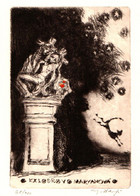Jaroslav Dajc
(b. 1943)
Czech Printmaker Jaroslav Dajc is the best represented book plate artist in my East European ex libris collection with fify—and still counting!—small format works in my listings. His fertile imagination comes up with ever new visual interpretations of stories from the Bible and classical mythology in prints both moody and mystical, whimsical and witty. You might find the Madonna and Christ Child with Pegasus the Flying Horse, or the Crucified Christ in the Garden of Eden, crammed next to the forbidden fruit tree, a serpent with an apple in its mouth, and a peacock, symbolizing eternal life to come with redemption from the Fall.
The Czech graphic artist’s stylishly strange body of work is all the more intriguing given the fact his formal art education was at Czech pedagogical institutes. Dajc taught drawing to primary school pupils and, later, print-making to high school art students, and his time in the classroom may well have shaped his idiosyncratic approach to artmaking. Czech Art Critic Karel Zhizkovsky describes Dajc as “a dreamer, a man with the soul of a child” who has a particular affinity with the great 20th century Czech visionary artist, Bohuslav Reynek.
For Dajc, art begins and ends with drawing. His favored form of printmaking is the drypoint, where he can wield a needle on a metal plate like a pencil on a sketchpad, adding volume to his linework with spare color washes. His emotionally explosive images appear sketchy and improvised, as if passionately made in a moment. Spindly, loose-jointed figures in prints like The Pilgrim at Rest (1), Lord Have Mercy, and Saint Sebastian seek solid supports with overlarge, grasping hands and fingers. Touch them the wrong way and they might collapse like puppets cut from strings. With just a bundle of scratched in lines, Dajc is able to convey the agony of Christ nailed to the Cross.
Dajc hails from the Czech Highlands, a picturesque region of low mountains stretching from Bohemia into Moravia, and has a special feeling for landscapes, often depicting them with churches and roadside devotional markers. In The Chapel on a Hill, a weary pilgrim climbs to a Baroque shrine just like one in Dajc’s home village of Havlickuv Brod. But the natural world, mostly, serves as a boldly lit stage for sacred show pieces like The Flight into Egypt, where the spotlighted actors seem small in the surrounding darkness, caught up in larger-than-life dramas. In two curious noctural Christmas scenes, a crowing rooster at the Nativity nearly steals the show from the Holy Family. A shepherd and sheep watch a shooting Star of Bethlehem plunge to earth.
The prolific print maker explores sacred themes in variations. A crucifix might appear in a niche with a vase of flowers in one print or draped with rosaries in a closet altar or a book-lined nook in others. A whole menagerie of creatures keeps Christ on the Cross company, bringing to mind folk tales where animals embody human vices and virtues. A spider sets down beside the Crucified Christ, while a pair of vultures waits for him to breath his last. In other prints, a falcon with its still living prey hovers near Christ, and the emaciated scapegoat of Jewish tradition clings to his bent body. Meaning piles upon meaning in these richly symbolic scenes.
Dajc depicts the Passion of Christ, especially the Crucifixion, at different moments from different angles. He is especially drawn to the Pieta motif in which the Virgin Mary tenderly cradles her dead son taken down from the Cross. In prints in the Collection, we see the Mother of Christ fallen on her knees to catch Christ’s body as a vulture plucks a nail from his hand or standing with the rigid, long-limbed corpse, her eyes turned to heaven. She can be seen lamenting over his lifeless form bent double on the ground and presenting the broken body to us as a sacrificial offering.
A second strand of Pieta imagery depicts the grieving Virgin Mother and her son as roadside shrines in rural landscapes. You can see the familiar outlines of such traditional Czech lamentation sculptures in broad daylight, in the final flare of the setting sun, and under a full moon in a forest. Stars blaze in the sky in another nighttime view of a Pieta on a pedastal, marked with one of the artist’s recurring splotches of red--but blink too soon and you might just miss that black cat, hellbent on fleeing the surreal world of Dajc’s sacred art!
(1)In the absence of titles from Dajc, I have made up my own to tell his many prints apart
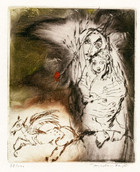
Madonna and Child with Pegasus
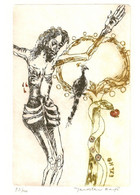
The Crucified Christ in Eden
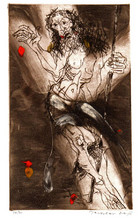
The Pilgrim at Rest
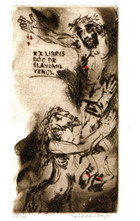
Lord, Have Mercy
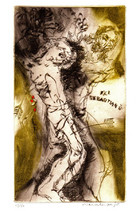
Saint Sebastian
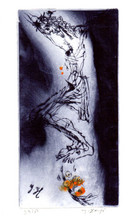
Nailed to the Cross
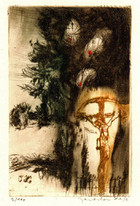
Wayside Crucifix
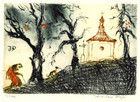
The Chapel on the Hill
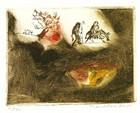
The Flight into Egypt
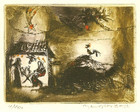
The Nativity with Rooster
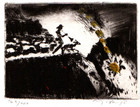
Shepherd and Falling Star
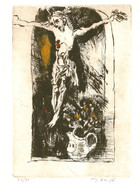
Crucifx and Vase with Flowers
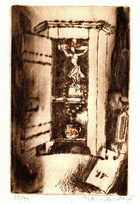
The Closet Altar
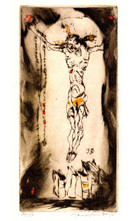
Crucifix with Rosary and Books
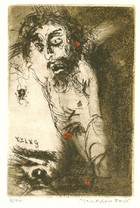
The Crucified Christ with Spider
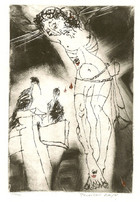
The Crucified Christ with Vultures
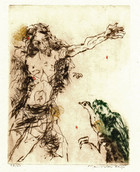
Christ on the Cross with Falcon
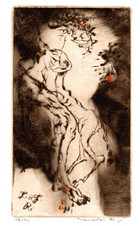
The Scapegoats
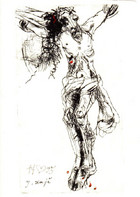
Christ on the Cross (1995)
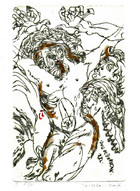
Golgotha
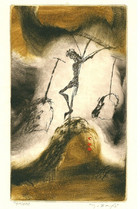
The Touched Landscape (Plate IV)
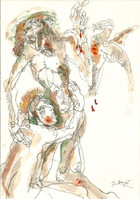
Stabat Mater
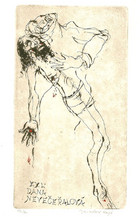
Standing Pieta
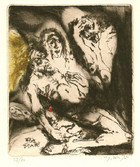
Pieta with the Apostle John
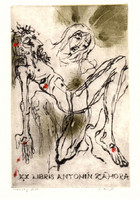
Descent from the Cross
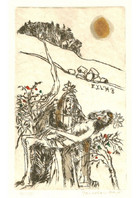
Noonday Pieta
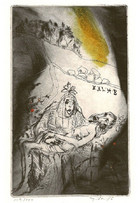
Sunset Pieta
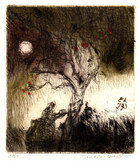
The Midnight Pieta
